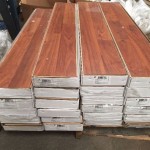Is Vinyl Flooring Toxic? Essential Aspects to Consider
Vinyl flooring has gained immense popularity in recent years due to its durability, versatility, and affordability. However, concerns regarding its potential toxicity have surfaced, sparking debates and uncertainties. To help clarify this matter, let's delve into the essential aspects of vinyl flooring and its toxicity.
Understanding Vinyl Flooring Materials
Vinyl flooring primarily consists of polyvinyl chloride (PVC), a synthetic material known for its strength and flexibility. PVC is combined with various additives, including plasticizers, stabilizers, and pigments, to enhance its performance and appearance.
Potential Toxic Components
Certain additives used in vinyl flooring can pose health concerns. These include:
- Phthalates: These chemicals are used as plasticizers to make vinyl flooring soft and pliable. Some phthalates have been linked to developmental issues in children and reproductive problems in adults.
- Heavy Metals: Some vinyl flooring products may contain trace amounts of heavy metals, such as lead and cadmium. Exposure to these metals can have adverse effects on the nervous system and other organs.
- Volatile Organic Compounds (VOCs): VOCs are chemical compounds released into the air from various sources, including vinyl flooring. Certain VOCs can cause eye, nose, and throat irritation and may contribute to long-term health issues.
Industry Standards and Regulations
The vinyl flooring industry has taken steps to address concerns about toxicity. Many manufacturers adhere to industry standards and regulations that limit the use of harmful additives. For example:
- FloorScore Certification: This certification indicates that vinyl flooring products meet stringent indoor air quality standards, ensuring low VOC emissions.
- Greenguard Gold Certification: Products with this certification have undergone rigorous testing and are deemed safe for use in schools, hospitals, and other environments where indoor air quality is critical.
Factors to Consider
When evaluating the toxicity of vinyl flooring, consider the following factors:
- Product Quality: Choose high-quality vinyl flooring products from reputable manufacturers that adhere to industry standards.
- Ventilation: Ensure adequate ventilation in rooms where vinyl flooring is installed, especially during and after installation.
- Installation Practices: Follow proper installation guidelines to minimize exposure to potential toxins.
- Health Considerations: Individuals with sensitivities to chemicals or who are concerned about long-term health effects may opt for alternative flooring options.
Conclusion
While vinyl flooring can contain potential toxic components, choosing products that meet industry standards and adhere to best practices can mitigate these concerns. By considering factors such as product quality, ventilation, and installation, you can minimize exposure and create a safe and healthy indoor environment.

The Dangers Of Luxury Vinyl Floors Lvt And How You Can Avoid Them Artisan Wood Llc

Are Vinyl Floors Toxic Olde Tyme Floor

Are Vinyl Floors Toxic Olde Tyme Floor

Vinyl Flooring Could Comes With A Health Toxic Phthalates

Is Vinyl Flooring Harmful To Health Singapore Laminate

Is Vinyl Flooring Harmful To Health Singapore Laminate

Is A Vinyl Floor Considered Toxic

The Dangers Of Luxury Vinyl Floors Lvt And How You Can Avoid Them Artisan Wood Llc

The Truth About Vinyl Flooring Four Ways To Protect Yourself Pure Living Space

Vinyl Flooring Pros And Cons Forbes Home
See Also







